建筑垃圾 中英文讲稿
英语演讲稿垃圾分类,改善环境 (2)

英语演讲稿垃圾分类,改善环境Ladies and gentlemen,Today, I am here to talk to you about a pressing issue that concerns us all – garbage classification. In recent years, the issue of waste management and environmental protection has gained widespread attention around the world. As our population continues to grow, so does the amount of waste we produce. It is imperative that we take action now to improve the environment and ensure a sustainable future for ourselves and future generations.The first step towards addressing this issue is to educate ourselves about the importance of garbage classification. Many of us often throw our garbage in a single bin without considering the consequences. However, when we fail to separate our waste, it becomes more difficult to recycle and dispose of it properly. As a result, landfills become overloaded, causing pollution and health hazards.By implementing an effective garbage classification system, we can significantly reduce the amount of waste that ends up in landfills. Several countries and cities have already adopted such systems with successful results. By separating our waste into different categories such as recyclable, organic, and non-recyclable, we can ensure that each type is disposed of properly. Recycling materials like paper, plastic, and glass not only reduces the strain on landfills but also conserves natural resources.Garbage classification also creates opportunities for job creation and economic growth. Recycling centers and waste management facilities require workers to sort, process, and manage the waste. By promoting garbage classification, we can generate employment opportunities and contribute to the local economy.Furthermore, proper waste disposal and recycling can help combat climate change. When garbage decomposes in landfills, it releases harmful greenhouse gases, contributing to global warming. By diverting waste from landfills through recycling and composting, we can significantly reduce greenhouse gas emissions and mitigate climate change.Finally, garbage classification is a collective responsibility. Each and every one of us must take action to make a difference. We can start by raising awareness in our communities and schools, educating others about the importance of garbage classification. Municipalities and governments can also play a crucial role by implementing effective waste management policies and infrastructure.In conclusion, garbage classification is essential for improving the environment and achieving sustainability. It is a step towards reducing pollution, conserving resources, and combating climate change. By educating ourselves, promoting awareness, and taking action, we can make a significant difference in the state of our environment. Let us work together to create a cleaner and healthier future for ourselves and future generations. Thank you.。
英语演讲稿垃圾分类,改善环境

英语演讲稿垃圾分类,改善环境Ladies and gentlemen,It is a great honor to be standing before you today to discuss a pressing issue that affects us all – garbage classification and environmental improvement. We live in an era where the consequences of our actions are becoming increasingly evident, and it is our responsibility to take action and make a difference. Garbage classification isone such action that can have a significant impact on our environment.The world is drowning in waste. Every year, billions of tons of garbage are generated, causing immense damage to our planet. From plastic pollution in our oceans to hazardous waste seeping into our soil, the consequences of improper waste management are dire. However, by implementing a proper garbage classification system, we can address this issue and start to alleviate the burden we have placed on the environment.Garbage classification involves the systematic separation of waste into different categories such as recyclables, organic waste, and hazardous materials. This allows for more efficient disposal and facilitates the recycling and reusing of materials. By recycling, we can reduce the need for extracting new raw materials, conserving energy and diminishing pollution levels. Additionally, organic waste can be used for composting, providing nutrient-rich soil for agriculture, and reducing the need for chemical fertilizers. Proper disposal of hazardous materials prevents contamination of water sources and protects human health.Implementing a garbage classification system requires collective action. Schools, communities, and governments must work together to raise awareness and provide the necessary infrastructure for waste separation and management. Education is key. It is crucial that we educate ourselves and future generations about the importance of garbage classification and its impact on our environment. By starting at a young age, we can instill the values and habits necessary for a sustainable future.Furthermore, reinforcing environmental laws and regulations, and encouraging businesses to adopt sustainable practices can contribute to the success of a garbage classification system. Businesses should be held accountable for their waste production and be incentivized to reduce, reuse, and recycle. Public campaigns and initiatives can also play a significant role in raising awareness and encouraging individuals to actively participate in waste management.By implementing a garbage classification system and improving waste management practices, we can significantly reduce the impact of garbage on our environment. Our actions today will determine the well-being of future generations. Let us work together to protect our planet, preserve our resources, and create a sustainable future for all. Thank you.。
垃圾分类演讲稿内容英文
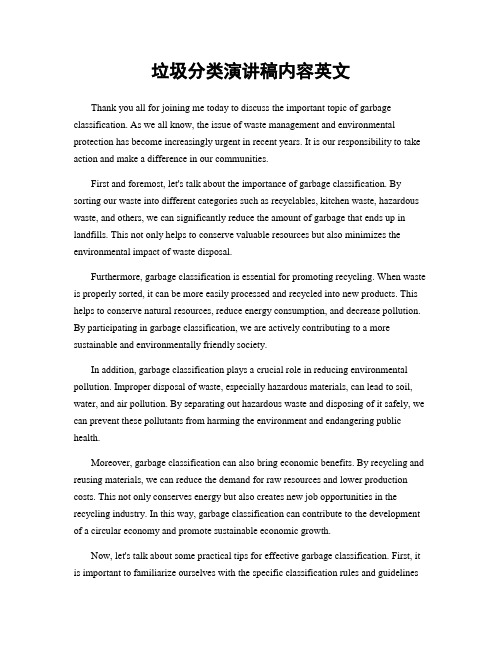
垃圾分类演讲稿内容英文Thank you all for joining me today to discuss the important topic of garbage classification. As we all know, the issue of waste management and environmental protection has become increasingly urgent in recent years. It is our responsibility to take action and make a difference in our communities.First and foremost, let's talk about the importance of garbage classification. By sorting our waste into different categories such as recyclables, kitchen waste, hazardous waste, and others, we can significantly reduce the amount of garbage that ends up in landfills. This not only helps to conserve valuable resources but also minimizes the environmental impact of waste disposal.Furthermore, garbage classification is essential for promoting recycling. When waste is properly sorted, it can be more easily processed and recycled into new products. This helps to conserve natural resources, reduce energy consumption, and decrease pollution. By participating in garbage classification, we are actively contributing to a more sustainable and environmentally friendly society.In addition, garbage classification plays a crucial role in reducing environmental pollution. Improper disposal of waste, especially hazardous materials, can lead to soil, water, and air pollution. By separating out hazardous waste and disposing of it safely, we can prevent these pollutants from harming the environment and endangering public health.Moreover, garbage classification can also bring economic benefits. By recycling and reusing materials, we can reduce the demand for raw resources and lower production costs. This not only conserves energy but also creates new job opportunities in the recycling industry. In this way, garbage classification can contribute to the development of a circular economy and promote sustainable economic growth.Now, let's talk about some practical tips for effective garbage classification. First, it is important to familiarize ourselves with the specific classification rules and guidelinesin our local area. Different regions may have different requirements for waste sorting, so it is essential to stay informed and follow the regulations accordingly.Second, we should make use of proper waste disposal facilities and containers. This includes using separate bins for different types of waste, such as paper, plastic, glass, and organic waste. By keeping our waste organized and separated, we can facilitate the recycling and processing of materials.Additionally, it is crucial to raise public awareness and encourage community participation in garbage classification. Education and outreach programs can help to inform people about the importance of waste management and motivate them to take action. By working together as a community, we can achieve greater success in waste reduction and environmental protection.In conclusion, garbage classification is a vital practice that holds significant benefits for the environment, society, and the economy. By properly sorting our waste, we can reduce the burden on landfills, promote recycling, prevent pollution, and create a more sustainable future. Let us all commit to making a positive impact through responsible waste management and garbage classification. Thank you.。
保护建筑垃圾英文作文

保护建筑垃圾英文作文英文:Protecting building waste is an important aspect of environmental protection. As we all know, construction waste is a major source of environmental pollution. If construction waste is not properly handled, it will cause serious environmental problems, such as soil pollution, water pollution, and air pollution. Therefore, it is necessary to take effective measures to protect construction waste.Firstly, it is necessary to classify and sort construction waste. Different types of construction waste should be treated differently. For example, concrete waste can be recycled and used as building materials, while hazardous waste should be treated and disposed of in a special way. By sorting and classifying construction waste, we can reduce the amount of waste and improve theefficiency of resource utilization.Secondly, it is necessary to strengthen the management of construction waste. Construction waste should be collected, transported, and disposed of in accordance with relevant laws and regulations. The government should also increase investment in the construction waste management industry, promote the development of construction waste recycling technology, and encourage the use of recycled materials.Thirdly, it is necessary to raise public awareness of construction waste management. The public should be educated on the importance of protecting construction waste and the harm caused by improper handling of waste. The public should also be encouraged to participate in the management of construction waste, such as sorting and classifying waste, and reporting illegal dumping.In conclusion, protecting construction waste is an important task in environmental protection. We should take effective measures to classify and sort construction waste, strengthen management, and raise public awareness. Only bydoing so can we reduce environmental pollution and achieve sustainable development.中文:保护建筑垃圾是环境保护的重要方面。
垃圾回收英语演讲稿带翻译
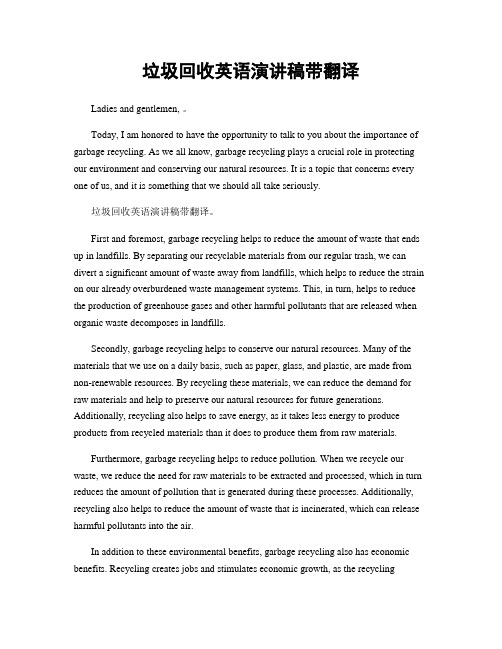
垃圾回收英语演讲稿带翻译Ladies and gentlemen, 。
Today, I am honored to have the opportunity to talk to you about the importance of garbage recycling. As we all know, garbage recycling plays a crucial role in protecting our environment and conserving our natural resources. It is a topic that concerns every one of us, and it is something that we should all take seriously.垃圾回收英语演讲稿带翻译。
First and foremost, garbage recycling helps to reduce the amount of waste that ends up in landfills. By separating our recyclable materials from our regular trash, we can divert a significant amount of waste away from landfills, which helps to reduce the strain on our already overburdened waste management systems. This, in turn, helps to reduce the production of greenhouse gases and other harmful pollutants that are released when organic waste decomposes in landfills.Secondly, garbage recycling helps to conserve our natural resources. Many of the materials that we use on a daily basis, such as paper, glass, and plastic, are made from non-renewable resources. By recycling these materials, we can reduce the demand for raw materials and help to preserve our natural resources for future generations. Additionally, recycling also helps to save energy, as it takes less energy to produce products from recycled materials than it does to produce them from raw materials.Furthermore, garbage recycling helps to reduce pollution. When we recycle our waste, we reduce the need for raw materials to be extracted and processed, which in turn reduces the amount of pollution that is generated during these processes. Additionally, recycling also helps to reduce the amount of waste that is incinerated, which can release harmful pollutants into the air.In addition to these environmental benefits, garbage recycling also has economic benefits. Recycling creates jobs and stimulates economic growth, as the recyclingindustry requires a workforce to collect, process, and distribute recyclable materials. Furthermore, recycling also helps to reduce the costs associated with waste disposal, as it is often cheaper to recycle materials than it is to dispose of them in landfills.In conclusion, garbage recycling is a crucial part of our efforts to protect the environment and conserve our natural resources. It helps to reduce the amount of waste that ends up in landfills, conserve our natural resources, reduce pollution, and stimulate economic growth. It is something that we should all take seriously and make an effort to incorporate into our daily lives. By recycling our waste, we can all play a part in creating a cleaner, healthier, and more sustainable world for future generations. Thank you.。
垃圾分类演讲稿英文

垃圾分类演讲稿英文Garbage Classification Speech。
Ladies and gentlemen,。
Today, I am honored to stand here and talk to you about the importance of garbage classification. As we all know, the issue of waste management has become increasingly urgent in our modern society. The rapid growth of population and urbanization has led to a massive increase in the amount of waste generated, posing a serious threat to the environment and human health. In order to address this pressing issue, it is crucial for us to promote and implement effective garbage classification practices.First and foremost, garbage classification is essential for reducing the amount of waste sent to landfills. By separating our waste into different categories such as recyclables, kitchen waste, hazardous waste, and non-recyclables, we can significantly decrease the volume of waste that ends up in landfills. This not only helps to conserve valuable land resources but also reduces the production of harmful greenhouse gases such as methane, which are generated from the decomposition of organic waste in landfills.Furthermore, garbage classification plays a vital role in promoting resource conservation and sustainable development. Through the recycling and reuse of materials such as paper, plastic, glass, and metal, we can minimize the extraction of raw materials from the environment and reduce energy consumption in the production of new products. This not only conserves natural resources but also helps to mitigate the environmental impact of resource extraction and manufacturing processes.In addition, garbage classification is crucial for protecting the environment and safeguarding public health. Improper disposal of hazardous waste such as batteries, electronic devices, and chemical products can contaminate soil, water, and air, posing serious risks to the ecosystem and human health. By separating and disposing of hazardous waste properly, we can prevent pollution and minimize the potential harm to the environment and human well-being.Moreover, garbage classification fosters environmental awareness and a sense of responsibility among individuals and communities. By actively participating in garbage classification activities, people can develop a better understanding of the environmental impact of their consumption and waste generation habits. This can lead to a more sustainable lifestyle and a greater commitment to environmental protection, both at the individual and collective levels.In conclusion, garbage classification is a fundamental practice that holds great significance for waste management, resource conservation, environmental protection, and public health. It is essential for us to raise awareness, promote education, and implement effective policies and initiatives to encourage and facilitate garbage classification at all levels of society. By working together to embrace garbage classification, we can make a positive impact on the environment, create a more sustainable future, and ensure the well-being of present and future generations.Thank you.。
垃圾分类,从小事做起——爱护环境英语演讲稿
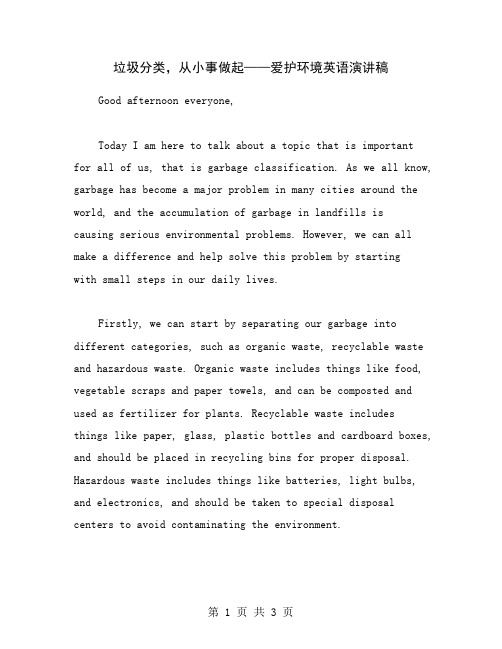
垃圾分类,从小事做起——爱护环境英语演讲稿Good afternoon everyone,Today I am here to talk about a topic that is importantfor all of us, that is garbage classification. As we all know, garbage has become a major problem in many cities around the world, and the accumulation of garbage in landfills iscausing serious environmental problems. However, we can all make a difference and help solve this problem by startingwith small steps in our daily lives.Firstly, we can start by separating our garbage into different categories, such as organic waste, recyclable waste and hazardous waste. Organic waste includes things like food, vegetable scraps and paper towels, and can be composted and used as fertilizer for plants. Recyclable waste includesthings like paper, glass, plastic bottles and cardboard boxes, and should be placed in recycling bins for proper disposal. Hazardous waste includes things like batteries, light bulbs, and electronics, and should be taken to special disposal centers to avoid contaminating the environment.Secondly, we can also reduce our waste by practicing the three R's 鈥?reduce, reuse and recycle. To reduce waste, we can start by choosing products with minimal packaging, and avoid single-use products like plastic bags and straws. To reuse, we can repurpose items like glass jars and shopping bags, and donate unwanted items to charities. Lastly, recycling is essential to keeping our environment clean, and we should make an effort to recycle as much as possible.Lastly, we need to raise awareness about the importance of garbage classification and environmental protection. We can do this by organizing community activities, such as environmental cleanup events and educational seminars. We can also encourage our friends and family to practice garbage classification and reduce waste in their daily lives.In conclusion, garbage classification is a simple yet effective way to contribute to environmental protection. We can all start by taking small steps in our daily lives, and by doing so, we can help to reduce pollution, conserve resources, and build a cleaner and more sustainable futurefor ourselves and future generations. Thank you all for listening, and let us all work together to make a positive change for our planet.。
垃圾分类,改善环境的英语演讲稿范文
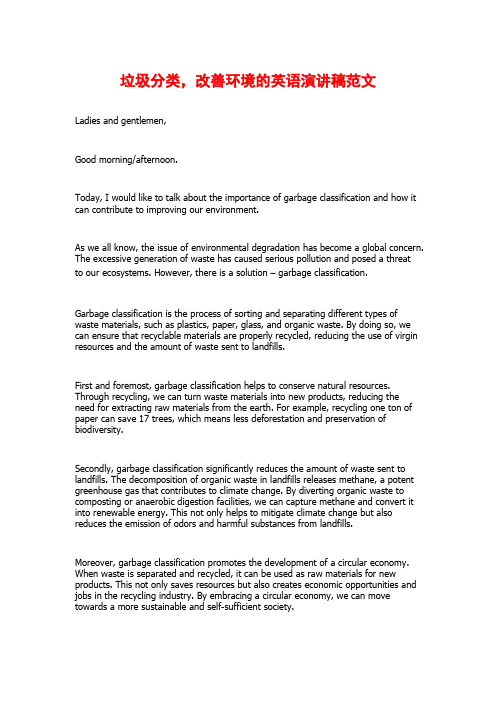
垃圾分类,改善环境的英语演讲稿范文Ladies and gentlemen,Good morning/afternoon.Today, I would like to talk about the importance of garbage classification and how it can contribute to improving our environment.As we all know, the issue of environmental degradation has become a global concern. The excessive generation of waste has caused serious pollution and posed a threatto our ecosystems. However, there is a solution – garbage classification.Garbage classification is the process of sorting and separating different types of waste materials, such as plastics, paper, glass, and organic waste. By doing so, we can ensure that recyclable materials are properly recycled, reducing the use of virgin resources and the amount of waste sent to landfills.First and foremost, garbage classification helps to conserve natural resources. Through recycling, we can turn waste materials into new products, reducing the need for extracting raw materials from the earth. For example, recycling one ton of paper can save 17 trees, which means less deforestation and preservation of biodiversity.Secondly, garbage classification significantly reduces the amount of waste sent to landfills. The decomposition of organic waste in landfills releases methane, a potent greenhouse gas that contributes to climate change. By diverting organic waste to composting or anaerobic digestion facilities, we can capture methane and convert it into renewable energy. This not only helps to mitigate climate change but also reduces the emission of odors and harmful substances from landfills.Moreover, garbage classification promotes the development of a circular economy. When waste is separated and recycled, it can be used as raw materials for new products. This not only saves resources but also creates economic opportunities and jobs in the recycling industry. By embracing a circular economy, we can move towards a more sustainable and self-sufficient society.Additionally, garbage classification raises awareness about consumption patterns and promotes responsible consumption. Through sorting our waste, we become more mindful of the materials we consume and the impact they have on the environment. This can lead to a shift towards a more sustainable lifestyle, where we prioritize reusable and eco-friendly products.In conclusion, garbage classification plays a vital role in improving our environment. Through this practice, we can conserve natural resources, reduce waste in landfills, promote a circular economy, and foster responsible consumption. It is up to each and every one of us to embrace garbage classification and make a positive contribution to our environment. Let us work together towards a cleaner, healthier, and more sustainable future.Thank you for your attention.。
减少塑料垃圾的演讲稿英文
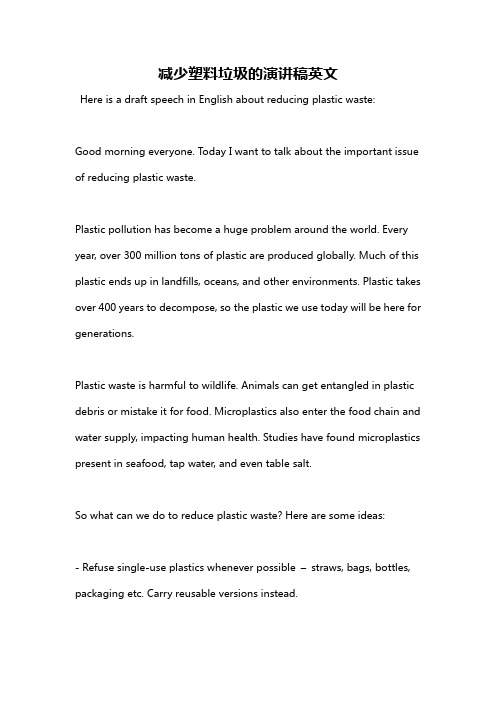
减少塑料垃圾的演讲稿英文Here is a draft speech in English about reducing plastic waste:Good morning everyone. T oday I want to talk about the important issue of reducing plastic waste.Plastic pollution has become a huge problem around the world. Every year, over 300 million tons of plastic are produced globally. Much of this plastic ends up in landfills, oceans, and other environments. Plastic takes over 400 years to decompose, so the plastic we use today will be here for generations.Plastic waste is harmful to wildlife. Animals can get entangled in plastic debris or mistake it for food. Microplastics also enter the food chain and water supply, impacting human health. Studies have found microplastics present in seafood, tap water, and even table salt.So what can we do to reduce plastic waste? Here are some ideas:- Refuse single-use plastics whenever possible –straws, bags, bottles, packaging etc. Carry reusable versions instead.- Support bans on certain non-essential plastic items like straws, bags and styrofoam take-out containers.- Choose products with minimal plastic packaging. Buy in bulk using your own reusable containers.- Recycle properly and advocate for improved recycling systems in your community.- Organize neighborhood plastic clean-ups to remove waste.- Spread awareness about this issue through social media, conversations with friends and family, and community events.Small individual actions add up to big change. If we all reduce our plastic use, companies and governments will follow. We must treat plastic waste as the urgent threat it is. Our oceans, wildlife, and our own health are at risk. But together, we can build a sustainable future free of plastic pollution. It starts with each of us.Thank you. Let's work together to reduce plastic waste.。
垃圾分类中英文结合

Other waste
includes bricks, ceramics, and other materials that are difficult to recycle and require safe disposal
Chinese English Comparison: Classification Standards and Terminology
Strengthening of supervision and enforcement
Governments should strengthen supervision and enforcement to ensure that garbage classification is implemented effectively
Environmental protection needs
Mitigation of environmental pollution
Improve disposal of garbage can lead to soil, water, and air pollution, affecting the ecological environment and human health
There are some differences in margin classification standards and terminology between China and English speaking countries
建筑垃圾治理英语
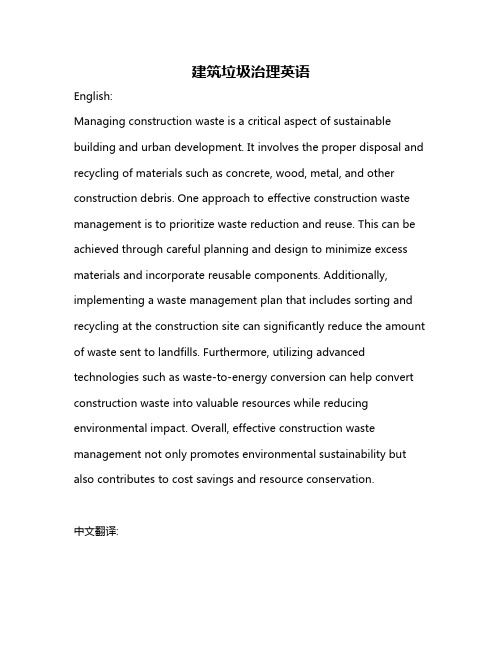
建筑垃圾治理英语English:Managing construction waste is a critical aspect of sustainable building and urban development. It involves the proper disposal and recycling of materials such as concrete, wood, metal, and other construction debris. One approach to effective construction waste management is to prioritize waste reduction and reuse. This can be achieved through careful planning and design to minimize excess materials and incorporate reusable components. Additionally, implementing a waste management plan that includes sorting and recycling at the construction site can significantly reduce the amount of waste sent to landfills. Furthermore, utilizing advanced technologies such as waste-to-energy conversion can help convert construction waste into valuable resources while reducing environmental impact. Overall, effective construction waste management not only promotes environmental sustainability but also contributes to cost savings and resource conservation.中文翻译:建筑垃圾的治理是可持续建筑和城市发展的关键方面。
2024小学生垃圾分类3分钟演讲稿最新样本英文版

2024小学生垃圾分类3分钟演讲稿最新样本英文版2024 Elementary School Students' 3-Minute Speech Sample on Garbage ClassificationHello everyone,Today, I want to talk to you about the importance of garbage classification. Garbage is a big problem in our world, and it's up to us to do something about it. We need to start separating our trash into different categories so that we can recycle and reuse as much as possible.First of all, let's talk about why garbage classification is important. When we throw everything into the same bin, it all ends up in a landfill. This creates a huge mess and takes up a lot of space. But when we separate our trash, we can send things like paper, plastic, and glass to recycling facilities where they can be turned into new products.Not only does garbage classification help reduce waste, but it also helps protect the environment. When trash sits in a landfill, it can release harmful chemicals into the air and water. By recycling and reusing our waste, we can help keep our planet clean and healthy for future generations.So, how can we start practicing garbage classification in our daily lives? It's simple! All we need to do is set up separate bins for different types of waste, such as paper, plastic, and food scraps. Then, we just need to make a habit of putting our trash in the right bin.In conclusion, garbage classification is a small change that can make a big difference. By taking the time to separate our trash and recycle as much as possible, we can help protect the environment and create a better world for everyone. So let's all do our part and start practicing garbage classification today!Thank you for listening.。
建筑垃圾的智慧作文

建筑垃圾的智慧作文英文回答:Building waste, also known as construction and demolition waste, is a significant issue that needs to be addressed in a smart and sustainable manner. It refers to the materials that are generated during the construction, renovation, and demolition of buildings. These materials include concrete, bricks, wood, metals, plastics, and other debris.One of the main reasons why building waste is a problem is because it takes up a large amount of space in landfills. This not only contributes to the depletion of natural resources but also leads to environmental pollution. Additionally, the improper disposal of building waste can pose health and safety risks to the public.To tackle this issue, it is crucial to adopt smart solutions for managing building waste. One such solution isrecycling. By recycling building materials, we can reduce the amount of waste that goes to landfills and conserve valuable resources. For example, concrete can be crushed and used as aggregate for new construction projects, while wood can be repurposed for furniture or flooring.Another smart approach is to promote the concept of "reduce and reuse." This means minimizing the amount of waste generated in the first place and finding ways to reuse materials. For instance, instead of throwing away old windows during a renovation, they can be refurbished and used again. This not only reduces waste but also saves money.Furthermore, it is essential to raise awareness among builders, contractors, and homeowners about the importance of proper waste management. Education and training programs can be organized to teach people about the benefits of recycling and reusing building materials. By encouraging a change in mindset and behavior, we can make a significant impact in reducing building waste.In addition to recycling and reusing, technological advancements can also play a role in managing building waste. For example, smart sensors can be installed in construction sites to monitor waste generation and optimize waste collection schedules. This can help preventoverfilling of dumpsters and ensure efficient waste disposal.中文回答:建筑垃圾,也被称为建筑和拆除废物,是一个需要以智慧和可持续方式解决的重要问题。
垃圾 英文演讲稿

垃圾英文演讲稿Ladies and gentlemen, 。
Today, I am here to talk to you about a topic that is not only important, but also urgent – the issue of garbage. Garbage, or waste, is a problem that affects every single person on this planet, and it is a problem that is growing at an alarming rate. In my speech today, I will discuss the impact of garbage on the environment, the consequences of our current waste management practices, and what we can do to address this critical issue.First and foremost, it is crucial to understand the impact of garbage on the environment. The amount of waste that we produce on a daily basis is staggering, and the vast majority of it ends up in landfills or in our oceans. This has devastating consequences for the natural world – it pollutes our air, water, and soil, and it poses a serious threat to the health of our planet. The sheer volume of garbage that we produce is simply unsustainable, and if we continue on our current path, we will soon reach a point of no return.Furthermore, our current waste management practices are simply not working. Landfills are filling up at an alarming rate, and our oceans are becoming increasingly polluted with plastic and other waste. This not only harms the environment, but it also has serious implications for human health. The toxins and pollutants that are present in our waste can leach into the soil and water, contaminating our food and water sources. In addition, the production and disposal of waste contribute to climate change, further exacerbating the environmental crisis that we are facing.So, what can we do to address this critical issue? The first step is to reduce our waste at the source. This means being more mindful of the products that we buy and the waste that we produce. We can also make a conscious effort to reuse and recycle as much as possible, and to support businesses and policies that promote sustainable waste management practices. In addition, we can advocate for stronger regulations and policiesthat hold individuals and corporations accountable for their waste production and disposal.In conclusion, the issue of garbage is one that cannot be ignored. It is a problem that affects every single person on this planet, and it is a problem that requires immediate action. We must all do our part to reduce our waste, support sustainable waste management practices, and advocate for policies that protect our environment. The time to act is now, and together, we can make a difference. Thank you.。
垃圾英语演讲稿
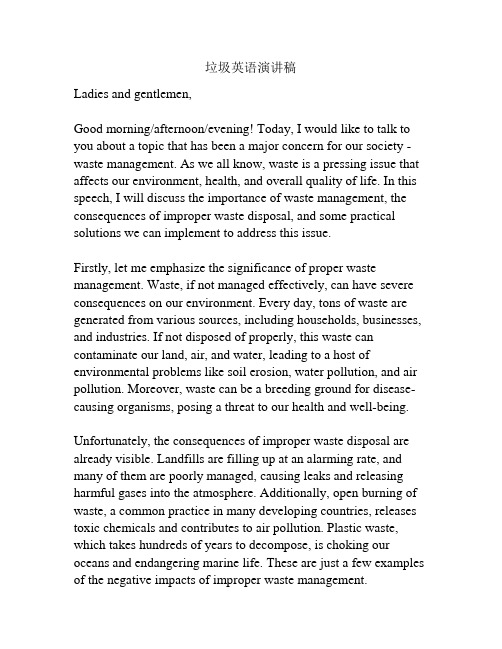
垃圾英语演讲稿Ladies and gentlemen,Good morning/afternoon/evening! Today, I would like to talk to you about a topic that has been a major concern for our society - waste management. As we all know, waste is a pressing issue that affects our environment, health, and overall quality of life. In this speech, I will discuss the importance of waste management, the consequences of improper waste disposal, and some practical solutions we can implement to address this issue.Firstly, let me emphasize the significance of proper waste management. Waste, if not managed effectively, can have severe consequences on our environment. Every day, tons of waste are generated from various sources, including households, businesses, and industries. If not disposed of properly, this waste can contaminate our land, air, and water, leading to a host of environmental problems like soil erosion, water pollution, and air pollution. Moreover, waste can be a breeding ground for disease-causing organisms, posing a threat to our health and well-being. Unfortunately, the consequences of improper waste disposal are already visible. Landfills are filling up at an alarming rate, and many of them are poorly managed, causing leaks and releasing harmful gases into the atmosphere. Additionally, open burning of waste, a common practice in many developing countries, releases toxic chemicals and contributes to air pollution. Plastic waste, which takes hundreds of years to decompose, is choking our oceans and endangering marine life. These are just a few examples of the negative impacts of improper waste management.Now, let's shift our focus to some practical solutions we can implement to address this issue. To begin with, recycling is a crucial aspect of waste management. By segregating waste into recyclable and non-recyclable materials, we can reduce the amount of waste that ends up in landfills. Governments and local authorities should invest in recycling facilities and promote awareness campaigns to encourage citizens to recycle. Furthermore, reducing waste at the source is equally important. This can be achieved by adopting sustainable practices such as using reusable bags, avoiding single-use plastic items, and opting for eco-friendly packaging materials.Another innovative solution is composting. Instead of disposing of organic waste, such as food scraps and yard trimmings, we can convert them into nutrient-rich compost. Composting not only reduces waste but also provides a valuable resource that can be used to enrich our soils and promote sustainable agriculture.In addition to these individual actions, collaborative efforts are crucial in tackling the issue of waste management. Governments, businesses, and communities must work together to develop effective waste management systems. This includes implementing waste segregation programs, improving waste collection and transportation infrastructure, and promoting research and development for innovative waste management technologies.In conclusion, waste management is a critical issue that demands our immediate attention. The consequences of improper waste disposal are already evident, and if we do not take action now, thesituation will only worsen. By implementing practical solutions such as recycling, waste reduction, composting, and collaborative efforts, we can mitigate the negative impact of waste on our environment and safeguard our future. Remember, the future is in our hands, and it is our responsibility to manage our waste effectively for the betterment of our planet and future generations.Thank you for your attention!Certainly! Here are some additional points and ideas to further explore the topic of waste management:1. The importance of education and awareness: In order to address the issue of waste management effectively, it is important to educate the public about the importance of proper waste disposal and the consequences of improper waste management. This can be done through awareness campaigns, workshops, and educational programs at schools and community centers. By raising awareness and instilling a sense of responsibility, we can create a culture of waste reduction and recycling.2. The role of governments and policies: Governments have a crucial role to play in promoting and implementing effective waste management practices. They can introduce and enforce regulations and policies that encourage waste reduction, recycling, and proper disposal. Governments can also provide financial incentives or tax breaks to businesses that adopt sustainable waste management practices. Additionally, governments should invest in improving waste collection and transportation infrastructure to ensure efficient and timely waste management.3. Encouraging innovation: Innovation and technologicaladvancements play a key role in waste management. Governments and businesses should invest in research and development to find new and improved methods for waste treatment and recycling. This could include exploring alternative energy generation from waste, implementing advanced waste sorting technologies, or developing sustainable packaging materials. Encouraging startups and entrepreneurs in the waste management sector can also lead to innovative and scalable solutions.4. International cooperation: Waste management is a global issue that requires collaboration and cooperation between countries. Developing countries can learn from the waste management practices of developed nations, while developed nations can provide technical and financial assistance to help improve waste management infrastructure in developing countries. International organizations and initiatives, such as the United Nations Environment Programme, can facilitate knowledge sharing and coordination among countries to address this global challenge.5. Encouraging circular economy: Shifting towards a circular economy is a holistic approach to waste management. Instead of the traditional linear model of "take-make-dispose," a circular economy aims to keep resources in use for as long as possible through recycling, reuse, and remanufacturing. This reduces waste generation and promotes the sustainable use of resources. Businesses can play a crucial role in adopting circular business models and designing products with recycling and reusability in mind.6. Collaboration with the informal sector: In many countries, theinformal sector, such as waste pickers and recyclers, plays a vital role in waste management. They often collect and sort recyclable materials and earn a livelihood from selling them. Governments and formal waste management systems should work with the informal sector, providing them with proper infrastructure, training, and fair compensation. Recognizing their contribution and incorporating them into the formal waste management system can lead to more efficient and inclusive waste management practices.7. Continuous monitoring and evaluation: It is crucial to constantly monitor and evaluate waste management practices to assess their effectiveness and identify areas for improvement. This includes measuring waste generation rates, tracking recycling rates, and monitoring the environmental impact of waste management activities. Regular audits and evaluations can help identify best practices, highlight success stories, and guide future policy decisions.In conclusion, effective waste management is an urgent need of our time. By adopting a multi-faceted approach that includes education, policy interventions, innovation, international cooperation, and collaboration with the informal sector, we can tackle this critical issue. Each and every one of us has a role to play in reducing waste and promoting responsible waste management practices. Let us all join hands and work together to create a sustainable future for generations to come. Thank you.。
保护建筑垃圾英文作文

保护建筑垃圾英文作文Building waste is a serious problem in many cities around the world. It not only takes up valuable space in landfills, but also contributes to environmental pollution. We need to find ways to protect our buildings and reduce the amount of waste they produce.One way to protect building waste is to promote recycling and reuse. By separating materials like metal, wood, and concrete, we can ensure that they are properly recycled and used in new construction projects. This not only reduces the amount of waste going to landfills, but also conserves valuable resources.Another way to protect building waste is to encourage sustainable construction practices. This includes usingeco-friendly materials, designing buildings with energy efficiency in mind, and incorporating green spaces into urban areas. By building in a more sustainable way, we can reduce the amount of waste produced and lessen our impacton the environment.Educating the public about the importance of protecting building waste is also crucial. By raising awareness about the impact of construction on the environment, we can encourage individuals to make more sustainable choices in their own building projects. This can help create a culture of responsible building practices that will benefit future generations.In conclusion, protecting building waste is essential for the health of our planet. By promoting recycling and reuse, encouraging sustainable construction practices, and educating the public, we can work together to reduce the amount of waste produced by buildings and create a more sustainable future.。
让建筑垃圾利用起来作文300
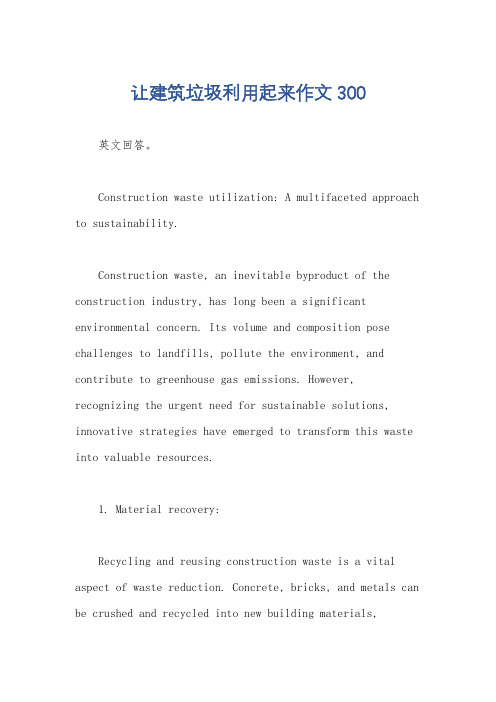
让建筑垃圾利用起来作文300英文回答。
Construction waste utilization: A multifaceted approach to sustainability.Construction waste, an inevitable byproduct of the construction industry, has long been a significant environmental concern. Its volume and composition pose challenges to landfills, pollute the environment, and contribute to greenhouse gas emissions. However, recognizing the urgent need for sustainable solutions, innovative strategies have emerged to transform this waste into valuable resources.1. Material recovery:Recycling and reusing construction waste is a vital aspect of waste reduction. Concrete, bricks, and metals can be crushed and recycled into new building materials,reducing the demand for virgin resources. This not only diverts waste from landfills but also conserves natural resources and reduces energy consumption.2. Energy recovery:Certain types of construction waste, such as wood and biomass, can be used as a source of energy through incineration or gasification. This process generates electricity or heat, reducing reliance on fossil fuels and diverting waste from landfills.3. Waste-to-product conversions:Innovative technologies enable the conversion of construction waste into value-added products. Gypsum, a byproduct of drywall manufacturing, can be transformed into agricultural soil amendments or plasterboard panels. Slag, a byproduct of steel production, can be used in road construction or as a cement substitute.4. Landfill diversion:Reducing the amount of construction waste sent to landfills is crucial. By implementing waste reduction practices, such as selective demolition and waste segregation, the volume of waste can be significantly diminished. Additionally, developing alternative disposal methods, such as engineered landfills or bioreactors, can mitigate the environmental impacts of landfilling.5. Design considerations:Incorporating sustainable design principles into construction projects can minimize waste generation. Using modular components, prefabrication techniques, and durable materials reduces waste during construction. Additionally, designing for adaptability and flexibility allows buildings to be easily modified or repurposed, extending their lifespan and reducing the need for demolition and waste disposal.中文回答。
- 1、下载文档前请自行甄别文档内容的完整性,平台不提供额外的编辑、内容补充、找答案等附加服务。
- 2、"仅部分预览"的文档,不可在线预览部分如存在完整性等问题,可反馈申请退款(可完整预览的文档不适用该条件!)。
- 3、如文档侵犯您的权益,请联系客服反馈,我们会尽快为您处理(人工客服工作时间:9:00-18:30)。
1:我是Cora,美国建筑与环境保护协会的学者。
I'm Cora, the scholar of America Association of Architectural and Environmental protection .Today,my topic is”Review of urban construction waste”.2:the first,What is construction waste?The second,Classification of construction waste.The third,Impact of construction waste on the environment.The forth,CDW Processing Technology.3:定义:建筑废弃物(即建筑垃圾)是指建设、施工单位或个人对各类建筑物、构筑物等进行建设、拆迁、修缮及居民装饰房屋过程中所产生的余泥、余渣、泥浆及其他废弃物。
"Construction waste" means any substance, matter or thing which is generated as a result of construction work and abandoned whether or not it has been processed or stockpiled before being abandoned.4建筑垃圾是指对建筑物、构筑物的建设、维修、拆除和装修的活动中产生的对建筑物本身无用或不需要的排出物料。
It is a mixture of surplus materials arising from site clearance, excavation, construction, refurbishment, renovation, demolition and road works.根据经验,新建项目产生的垃圾数量大约为建筑项目原材料总量的10%--20%.According to experience, the amount of garbage generated new project is about 10%--20% of the total construction project of raw materials5超过90%的建筑垃圾是惰性的,被称为公众填料。
公众填料包括碎片,瓦砾,泥土和混凝土,适用于土地复垦和土地平整。
Over 90% of construction waste are inert and are known as public fill. Public fill includes debris, rubble, earth and concrete which is suitable for land reclamation and site formation.剩余的非惰性物质的建筑废物包括竹,木材,植被,包装废弃物和其他有机材料。
相反,公众填料,非惰性废物是不适合的土地复垦和受重用/可回收物品的回收,被弃置在堆填区。
The remaining non-inert substances in construction waste include bamboo, timber, vegetation, packaging waste and other organic materials. In contrast to public fill, non-inert waste is not suitable for land reclamation and subject to recovery of reusable/ recyclable items, is disposed of at landfills.6建筑业的贡献的废物流中的一个主要部分在美国。
The construction industry contributes a major portion of the waste stream in the United States. Reduction of construction waste is a major topic .美国建筑材料消耗US Construction Material Consumption从图中可以看出建筑材料消耗急剧增加,尤其是近20年。
As can be seen from the graph construction material consumption increased rapidly, especially in recent 20 years.欧洲CDW增长和中国建筑生产总值EU CDW increase - China Construction Product“中国可能成为最大的建筑浪费国”.China may become the biggest construction waste States.7:随着城市化和人口膨胀,垃圾问题严重得多,这些年比过去;因此,废物管理已经以保护环境已经从政府压制的问题。
With the urbanization and population expansion ,the waste problems are much more serious these year than in past; therefor e, waste management had been a pressed issue from the government in order to protec t the environment.建筑垃圾的扩张不仅是资源的巨大消耗,但也导致了严重的环境污染,从而创造负面影响的环保产业和社会的可持续发展。
The expansion of construction wastes not only represents an enormous dissipati on of resources but also results in serious environmental pollution, thus creating negat ive effects to the sustainable development of environmental industry and society.8:数量大,普遍性,经常性,污染性是建筑垃圾的特点。
The number of large, widespread, frequent, pollution is characteristic of construction waste.there are so many construction waste that more and more lands are occupied.9:由于有越来越多的高度房屋建筑和老城市的改造需求将不可避免地恶化了环境,而无需废物管理。
As there are highly increasing demands on house buildings and the rebuilding of the old cities will inevitably worsen the environment without waste management.如果没有强制性的规定和合同的要求(更糟糕的是,有没有这样的法律规定,目前),大多数项目都混了不同的废物一起送到垃圾填埋场直接。
Without compulsory rules and contract requirements (and what’s more, there is no this kind of laws and requirements at present), most projects all mixed the different waste together and send to landfill directly.10有些垃圾直接被放置在河边,与此同时有些户外垃圾被雨水浸泡,导致的结果是水污染。
Some garbage is placed directly in the river, while some rain soaked outdoor trash, resulting in the pollution.1112Health & Ecological Risks deriving from CDW (f.e. asbestos fibres)建筑垃圾对卫生和生态造成的危险(如石棉纤维)German Reichstag Berlin, the demolition of this building in the center of east Berlin was delayed for several years due to the ‘asbestos’problems.位于德国东柏林市中心的德国国会大厦。
由于“石棉”问题,这座大厦的拆除延迟了几年。
Other contamination or hazardous waste materials: 其他受污染或危险废物材料包括:PCBs, Cyanides, Cr VI, Heavy metals (lead containing paints, mercury switches, neon bulbs,..), mineral oil, solvents, >1 % asbestos containing materials, pesticides, radioactive contamination,..PCB、氰化物、Cr VI、重金属(含铅油漆、水银开关、氖灯管等)、矿物油、溶剂、石棉含量大于1%的材料、杀虫剂、放射性污染物等13建筑公司用较低的沉积成本和较低的受益减少废物的产生采购成本原生材料。
Construction companies benefit from reduced waste generation by lower deposition costs and lower purchasing costs virgin materials.施工活动产生的各类建筑垃圾,包括土壤,污泥(剩余的涂料和抛弃材料等)等,其中还包括可变的可回收材料,如钢材和木材的浪费。
可回收的废物一些研究发达国家作出的比例高达95%,即整体的废物,只有百分之五是不可回收。
